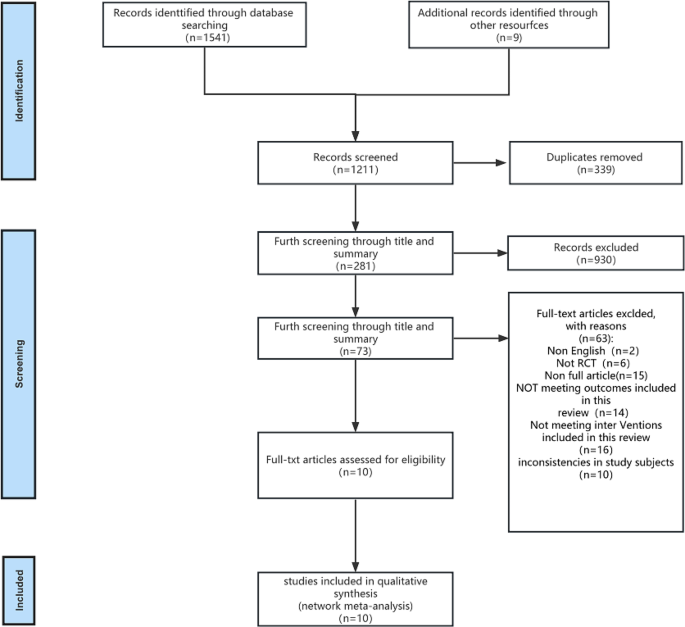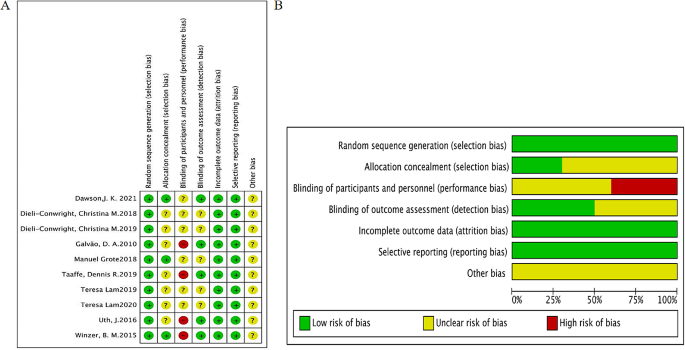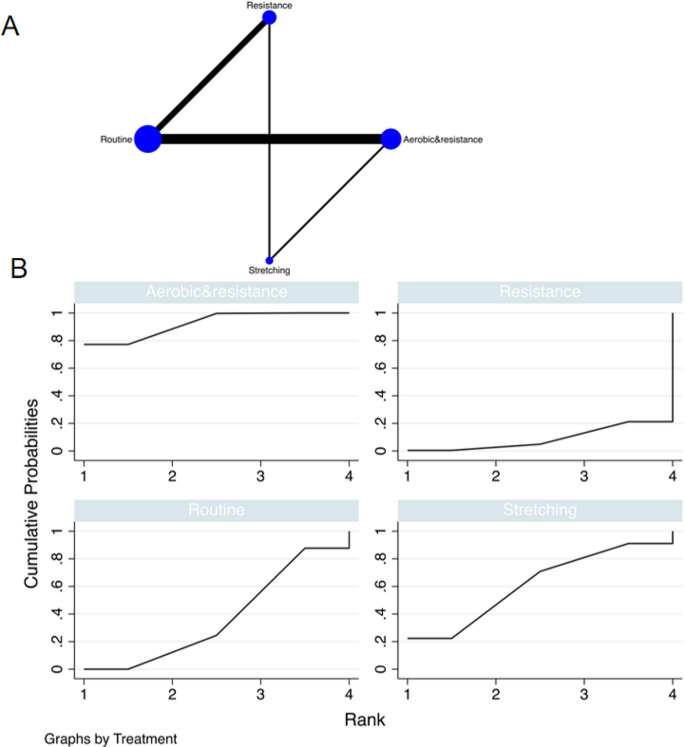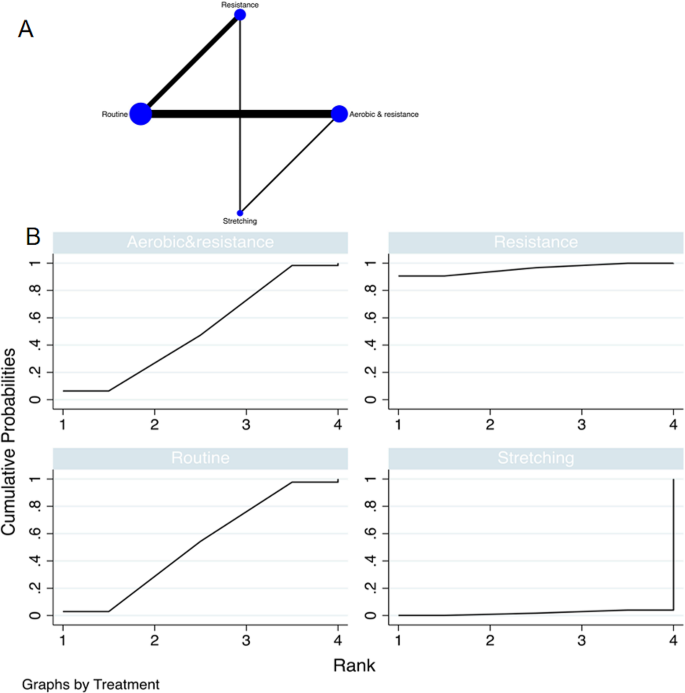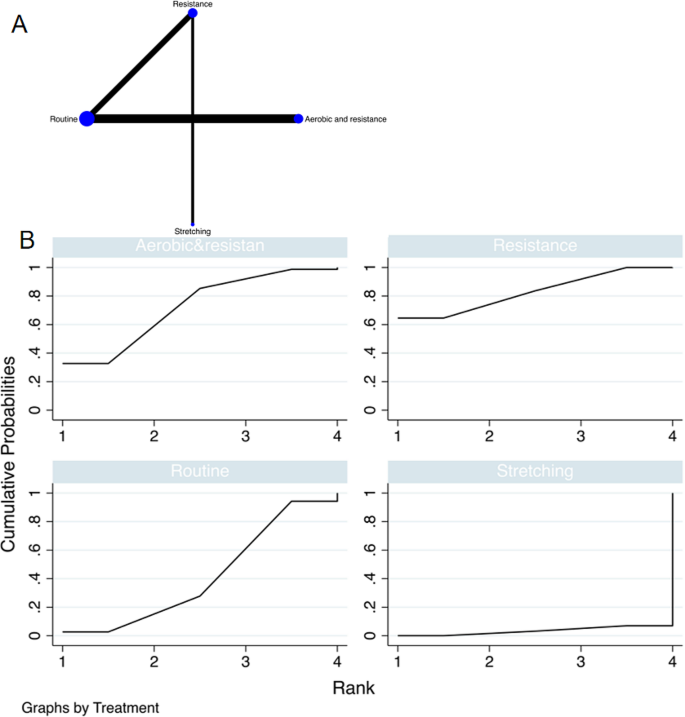- Systematic Review
- Open access
- Published:
Network meta-analysis of the intervention effects of different exercise measures on Sarcopenia in cancer patients
BMC Public Health volume 24, Article number: 1281 (2024)
Abstract
Purpose
This study aims to investigate the impact of four exercise modes (aerobic exercise, resistance exercise, aerobic combined with resistance multimodal exercise, and stretching) on the physical performance of cancer patients.
Methods
Randomized controlled trials (RCTs) were exclusively collected from PubMed, EMBASE, Web of Science, and The Cochrane Library, with a search deadline of April 30, 2023. Different exercise interventions on the physical performance of cancer patients were studied, and the Cochrane risk of bias assessment tool was employed to evaluate the quality of the included literature. Data analysis was conducted using STATA 15.1 software.
Results
This study included ten randomized controlled trials with a combined sample size of 503 participants. Network meta-analysis results revealed that aerobic combined with resistance multimodal exercise could reduce fat mass in cancer patients (SUCRA: 92.3%). Resistance exercise could improve lean mass in cancer patients (SUCRA: 95.7%). Furthermore, resistance exercise could enhance leg extension functionality in cancer patients with sarcopenia (SUCRA: 83.0%).
Conclusion
This study suggests that resistance exercise may be more beneficial for cancer-related sarcopenia.In clinical practice, exercise interventions should be tailored to the individual patients’ circumstances.
Registration number
This review was registered on INPLASY2023110025; DOI number is https://doi.org/10.37766/inplasy2023.11.0025 .
Background
Sarcopenia is a systemic syndrome characterized primarily by the weakening or loss of muscle mass and function [1]. Its pathogenesis is associated with inflammatory responses, hormone levels, and insulin resistance within the body, subsequently leading to disruptions in protein synthesis and the onset of sarcopenia [2, 3]. Based on differing mechanisms of occurrence, sarcopenia is classified into primary (i.e., degenerative) and secondary types, with the former being more prevalent among older people. At the same time, the latter is commonly observed in cases of chronic wasting. Tumor patients constitute a prominent demographic affected by secondary muscle atrophy, with an incidence rate of approximately 38.6%. This condition is closely linked to postoperative complications, chemotherapy toxicity reactions, and overall survival rates [4]. Statistics reveal that for tumor patients, a 25% reduction in body mass corresponds to a loss of 75% of skeletal muscle myocardium protein. Even more concerning, sarcopenia is responsible for approximately one-fifth of all tumor-related fatalities [5,6,7].
So far, the existing drug treatments have not been entirely satisfactory, and the accompanying side effects and high medical costs have restricted the clinical application of such therapies. Therefore, the search for a cost-effective, low-side-effect, non-pharmaceutical alternative has become increasingly important. Several studies suggest that exercise interventions can effectively delay the onset of sarcopenia in cancer patients, improve their quality of life, and extend their survival periods, making them the most efficient measure for treating sarcopenia [8,9,10,11]. However, due to the diverse nature and distinct characteristics of exercise intervention measures, there is currently no unanimous consensus on which exercise intervention is the most effective.
Network meta-analysis is an advanced, evidence-based technique that enables direct or indirect comparisons of the effects of multiple interventions on a particular disease and ranks their relative efficacy for improvement [12]. In this study, we aim to evaluate the impact of various exercise interventions on the physical performance of cancer patients with sarcopenia. By comparing these exercise interventions, we aim to provide valuable insights for healthcare professionals and patients.
Materials and methods
Search strategy
Through a computer search encompassing four electronic databases, namely PubMed, EMBASE, Web of Science, and The Cochrane Library, covering the period from their inception to April 2023, the retrieval strategy was structured by the PICOS framework: (P) Population: cancer patients; (I) Intervention: exercise; (C) Control Group: a control group receiving standard care or stretching exercises exclusively; (O) Outcomes: lean mass, fat mass, and leg extension test (leg extension); (S) Study Type: randomized controlled trials. Taking PubMed as an example, the detailed search strategy is shown in Table 1.
Inclusion criteria
(1) The experimental group and various exercise training methods as interventions for tumor patients. (2) The control group comprises patients receiving exercise interventions distinct from those in the experimental group or receiving routine care. (3) A clinical randomized controlled trial. (4) Outcomes encompass at least one of the following indicators: lean mass, fat mass, and leg extension test.
Exclusion criteria
(1) Literature lacking complete or accessible data; (2) non-randomized controlled trials, including quasi-randomized controlled trials and animal studies; (3) conference abstracts, case reports, and communications; (4) outcome measures that cannot be converted or aggregated; (5) literature not in the English language.
Study selection
Literature screening and exclusion were carried out using EndNote 20, a literature management software. Initially, two researchers independently conducted literature screening using the inclusion and exclusion criteria. Duplicate titles, non-randomized controlled trial studies, retrospective papers, conference papers, protocols, and correspondence were eliminated. Subsequently, the abstracts of the remaining literature were reviewed to determine their inclusion or exclusion. Any remaining literature was then subjected to a cross-check and comparison by both researchers. If the assessments were identical, the literature was included; in cases of disagreement, the third investigator facilitated discussion and resolution.
Data extraction
Seven predetermined data elements were chosen: (1) author’s name, (2) year of publication, (3) country, (4) study duration, (5) sample size, (6) mean age, and (7) outcome measures for exercise intervention.
Literature quality evaluation
The assessment of literature quality was conducted independently by two researchers, with a subsequent thorough review of the results. In cases of disagreement, a third party was consulted for evaluation. The evaluation of the risk of bias was carried out using the Cochrane 5.1.0 Risk Assessment Tool (ROB), considering seven key domains: (1) random sequence generation; (2) allocation concealment; (3) blinding of participants and experimenters; (4) investigator blinding; (5) completeness of outcome data; (6) selective reporting of results; and (7) other potential sources of bias. Each domain was categorized as having “high risk of bias,” “low risk of bias,” or “unclear.” Trials were then stratified into three levels of risk of bias based on the number of components with high ROB: high risk (5 or more), moderate risk (3 to 4), and low risk (2 or fewer) [13]. The results were ultimately presented in charts and tables.
Data analysis
Employing various exercise interventions, all outcome measures were treated as continuous variables, and the presentation and analysis included mean, standard deviation (SD) and mean-variance (MD, representing the absolute difference between the treatment and control groups and calculated using the same sample size) or standardized mean difference (SMD, indicating the mean of the groups divided by the standard deviation between subjects, suitable for data analysis in trials of varying sizes), along with 95% confidence interval (CI) [14]. Given the heterogeneity among studies, we opted for a random effects model for the analysis rather than a fixed effects model [15].
The Stata software, version 15.1, was employed for the NMA summary and analysis, utilizing the Bayesian Markov Chain Monte Carlo algorithm. To assess consistency, node splitting was applied, with a threshold of a p-value greater than 0.05 indicating the use of the consistency model; otherwise, the inconsistency model was employed [16]. Stata generated the network graph, where each node represents an independent intervention, and the connecting lines between nodes signify direct comparisons between interventions. The size of each node and the width of the lines are proportional to the number of trials conducted [17].
The greater the SUCRA value, the higher the likelihood of being the most effective intervention [17]. When determining the ranking of SUCRA, in addition to comparing the area under the cumulative ranking probability curve for different exercise interventions (surface under the cumulative ranking, SUCRA), it is essential to interpret the clinical significance of these interventions carefully. Furthermore, to address the possibility of publication bias in NMA, we constructed a network funnel plot and visually assessed its symmetry to detect the presence of small-sample effects [17].
Results
Literature screening process
Following a thorough search across multiple databases, an initial screening identified 1,541 relevant articles. A manual search yielded nine more articles, and with the assistance of Endnote software, 339 duplicate entries were removed. Subsequent examinations of titles and abstracts resulted in excluding 1,106 articles deemed irrelevant. This process left 73 articles for full-text evaluation, eventually culminating in the inclusion of 10 pieces in the meta-analysis (Fig. 1).
Literature quality evaluation
Out of the ten studies included [11, 18,19,20,21,22,23,24,25,26], 2 of them [11, 22] were categorized as low risk, while 8 [11, 20, 22, 25] were classified as medium risk. All the included studies referred to random allocation, with 4 [11, 18, 20, 21] explicitly mentioning the use of computerized grouping, while the remaining literature indicated randomization. In three [11, 21, 22] of the studies, a specific concealed allocation scheme was proposed. Due to the nature of the exercise intervention, achieving blinding for both the subjects and assessors was challenging, as patients and their families needed to provide informed consent before participating in the experiments. All the studies described the rate and reasons for loss to follow-up, and the outcome measures were comprehensive. The baseline characteristics of the intervention groups were reasonably balanced, with no signs of selective reporting. For detailed information, please refer to Fig. 2A and B.
Basic characteristics of the included literature
This study incorporated ten randomized controlled trials (RCTs), encompassing 503 patients diagnosed with malignancies, with 310 male and 193 female participants. The selected studies contained four distinct types of exercises models: 5 RCTs introduced resistance exercises in the experimental group [11, 19, 21, 25], 5 RCTs implemented aerobic combined with resistance multimodal exercise [16, 18, 22,23,24], and 2 RCTs within the control group utilized stretching exercises [11, 22], while the remaining control groups involved routine activities without any additional interventions. All ten of the included studies reported fat mass as an outcome measure [11, 18,19,20,21,22,23,24,25,26], lean mass as an outcome measure [11, 18,19,20,21,22,23,24,25,26], and six studies measured leg extension as an outcome indicator [11, 18,19,20,21,22]. These studies were distributed across regions, with three originating from the Americas, two from Europe, and six from Oceania. Detailed characteristics of the included studies are presented in Table 2.
Mesh Meta-analysis results
The full figures are detailed in Figs. 3A and 4A, and 5A.
Fat mass
A total of 10 randomized controlled trials (RCTs) was included, and multiple exercise interventions, primarily focusing on routine exercise, formed a complex network structure comprising two interconnected loops. The node-splitting test assessed the consistency between indirect and direct outcomes from all studies. The results of the network meta-analysis indicated that stretching [MD = -4.02, 95% CI = (10.42, 2.38)] and aerobic combined with resistance multi modal exercise [MD = -6.09, 95% CI = (-10.84, -1.34)] exhibited superior performance compared to conventional practice in comparison with the control group. The top-ranking intervention, based on the best-ranking results, was aerobic combined with resistance multimodal exercise, demonstrating the most effective reduction in tumor fat mass (SUCRA: 92.3%, as depicted in Fig. 3B). Further comparisons between different exercise interventions are presented in Table 3.
Lean mass
A total of 10 randomized controlled trials (RCTs) were included in the analysis. Multiple exercise interventions, predominantly centered around routine exercises, formed a complex network structure, resulting in two interconnected closed loops. Consistency between indirect and direct outcome indicators from all studies was evaluated. The network meta-analysis revealed that resistance exercise [MD = 14.00, 95% CI = (4.41, 23.60)] outperformed conventional exercise compared to the control group. The highest-ranking results demonstrated that resistance exercise was the most effective in increasing lean mass in tumor patients with sarcopenia (SUCRA: 95.7%, as depicted in Fig. 4B). Detailed comparisons between the various exercise interventions can be found in Table 4.
Leg extension
A total of 6 randomized controlled trials (RCTs) were incorporated into the study, and various exercise interventions were primarily based on routine exercises, resulting in a complex network structure with a closed loop. To assess the consistency between indirect and direct indicators from all studies, the node-splitting test was employed. The network meta-analysis indicated that resistance exercise [MD = 68.27, 95% CI = (26.25, 110.30)] and aerobic combined with resistance multimodal exercise [MD = 57.97, 95% CI = (5.23, 121.16)] outperformed the control group. The top-ranking results highlighted that resistance exercise was the most effective in enhancing the Leg extension function in cancer patients with sarcopenia (SUCRA: 83.0%, as displayed in Fig. 5B). Detailed comparisons between the diverse exercise interventions can be found in Table 5.
Publication bias trial
A publication bias funnel plot was generated for the intervention effect indicators of various exercise modalities on sarcopenia in cancer patients (Fig. 6A, B and C), and no notable publication bias was observed upon visual inspection of the funnel plot.
Discussion
A total of 10 randomized controlled trials (RCTs) were included, comprising a combined total of 503 cancer patients. Through the comparative analysis of the effects of various exercise interventions, including aerobic exercise, resistance exercise, aerobic resistance combined with multimodal training, and stretching exercise in cancer patients, our study demonstrates that differences in exercise interventions highlight the variability in their capacity to enhance sarcopenia and function in patients with sarcopenia-related tumours. Cancer patients must select targeted exercise interventions carefully. Resistance exercise exhibits the most favourable impact on improving lean mass and leg extension, while aerobic combined with resistance multimodal exercise is most effective in reducing fat mass in tumor patients with sarcopenia. Upon a comprehensive assessment, we assert that resistance exercise is competitive in ameliorating sarcopenia in cancer patients.
While ‘sarcopenia’ is defined as the loss of muscle mass or function, it is increasingly acknowledged that sarcopenia can also coexist with obesity. Excessive fat can obscure the absence of skeletal muscle mass. Thus, the measurement of fat mass is an essential component in the diagnosis of sarcopenia. Early detection, diagnosis, and exercise intervention are pivotal for prognosis improvement and sarcopenia treatment [27,28,29]. For cancer patients, engaging in 150 min of moderate or 75 min of high-intensity exercise per week is deemed safe. It can reduce abnormal lipid accumulation in skeletal muscle, enhance glucose circulation metabolism, and decrease fat mass [18, 30,31,32]. Regular fat mass measurements enable dynamic patient monitoring and adjustment of the regimen to achieve the optimal treatment outcome. The results demonstrate that combined resistance exercise is effective in reducing fat mass, which is statistically significant when compared to the control group. In contrast to resistance exercise, aerobic combined with resistance exercise offers more diversity, not only increasing exercise engagement but also boosting participants’ motivation, thus yielding more pronounced exercise effects.
Within the domain of studies about “sarcopenia,” assessments of lean mass (also known as lean weight or fat-free mass) are customarily incorporated, as they represent one of the paramount indicators of sarcopenia [31]. The reduction in muscle mass observed in sarcopenia often stems from a combination of muscle atrophy and cell death. At the molecular level, previous research has pointed to the association between sarcopenia and mitochondrial dysfunction, along with alterations in protein synthesis and degradation [32,33,34]. The measurement of lean mass allows us to furnish concrete evidence regarding the effectiveness of exercise interventions on skeletal muscle. Exercise interventions have the potential to stimulate the production of crucial regulatory components within skeletal muscle mitochondria, suppress ubiquitin-proteasome system (UPS) activity, enhance the expression of autophagy-related genes, improve mitochondrial oxidative capacity, and increase muscle blood flow [35,36,37]. Our findings indicate that resistance exercise yields significant intervention effects on lean mass in patients with tumor-related sarcopenia. This can be attributed to the stimulation of mitochondrial “biogenesis” through resistance exercise, which accelerates muscle cell signalling, increases mitochondrial count, enhances glucose transporter capacity and reduces the production of muscle growth inhibitors. Consequently, this process inhibits the proliferation and differentiation of myoblasts in developing muscles [38,39,40].
The relationship between lower limb strength and physical function is more closely intertwined than that of the upper limbs. Resistance exercise has found widespread use in the treatment of tumor-related sarcopenia patients. Impedance exercise, involving the application of external force to facilitate synergistic and antagonistic muscle training, can enhance lower limb muscle strength and endurance among patients with tumor-related sarcopenia, thus leading to improved leg extension function. Our results demonstrate a significant intervention effect of resistance exercise on leg extension function in tumor-related sarcopenia patients. This can be attributed to the requirements of muscle strength during resistance exercise, which consequently impacts the power of muscle motor units and the number and type of muscle fibers and fosters muscle growth and repair. Such improvements in muscle contraction afford patients greater control during leg extension, reducing muscle fatigue and pain [38,39,40]. Furthermore, the persistent mechanical strain on osteocytes induced by resistance training can promote their physical deformation, subsequently expediting bone remodeling and tissue regeneration and ultimately enhancing bone density [41]. Therefore, the study of tumor-related sarcopenia patients underscores that regular resistance exercise training represents a practical approach for restoring and enhancing leg extension function, ultimately improving the overall quality of life.
Advantage and limitations
Therapies aimed at addressing tumor-induced sarcopenia have garnered significant attention. Moderate exercise has demonstrated its potential to enhance overall bodily function and augment muscle mass in tumor patients. This study consolidates data from 10 eligible studies involving 503 patients to corroborate the efficacy of four exercise modes: resistance exercise, aerobic combined resistance multimodal exercise, and stretching exercise. In comparison to the meta-analysis of relevant literature, resistance exercise has shown a more pronounced impact on patients by bolstering both muscle strength and mass. This study provides valuable guidance for future research endeavors.
This study has its limitations. First, it relies on currently available English literature about tumor sarcopenia, which may introduce certain constraints to the study findings. Second, there exists some degree of heterogeneity and bias in the study results. Third, the research is influenced by variations in disease types, cultural backgrounds, and the healthcare systems of cancer patients. Therefore, it is imperative to tailor exercise interventions to individual needs based on the specific circumstances of each patient. Our study has not yet included aerobic capacity testing and leg press testing, and thus cannot assess physical performance, which is what we are working towards in the future.
Conclusion
The findings of this study underscore the superiority of resistance exercise over other exercise modalities in enhancing muscle mass and function. Consequently, the inclusion of resistance exercise in the rehabilitation regimen for cancer patients is of paramount importance. Tailoring the intervention to the individual circumstances of the patients and implementing it promptly is crucial for achieving optimal outcomes. Additionally, further investigation into the specific application methods and results of exercise in the rehabilitation of cancer patients is warranted to offer more scientifically informed guidance for clinical practice.
Data availability
The datasets used and/or analysis during the current study are available from the corresponding author on reasonable request.
Abbreviations
- RCTs:
-
Randomized controlled trials
- ROB:
-
Risk Assessment Tool
- SD:
-
Standard deviation
- CI:
-
Confidence interval
References
Kim JW, Kim R, Choi H, Lee SJ, Bae GU. Understanding of Sarcopenia: from definition to therapeutic strategies. Arch Pharm Res. 2021;44:876–89.
Liguori I, Russo G, Aran L, Bulli G, Curcio F, Della-Morte D, et al. Sarcopenia: assessment of disease burden and strategies to improve outcomes. Clin Interv Aging. 2018;13:913–27.
Delmonico MJ, Harris TB, Visser M, Park SW, Conroy MB, Velasquez-Mieyer P, et al. Longitudinal study of muscle strength, quality, and adipose tissue infiltration. Am J Clin Nutr. 2009;90:1579–85.
Couderc AL, Liuu E, Boudou-Rouquette P, Poisson J, Frelaut M, Montégut C et al. Pre-therapeutic Sarcopenia among Cancer patients: an Up-to-date Meta-analysis of Prevalence and Predictive Value during Cancer Treatment. Nutrients. 2023;15.
Halvorsen TO, Valan CD, Slaaen M, Grønberg BH. Associations between muscle measures, survival, and toxicity in patients with limited stage small cell lung cancer. J Cachexia Sarcopenia Muscle. 2020;11:1283–90.
Feliciano EMC, Kroenke CH, Meyerhardt JA, Prado CM, Bradshaw PT, Kwan ML, et al. Association of Systemic Inflammation and Sarcopenia with Survival in Nonmetastatic Colorectal Cancer: results from the C SCANS study. JAMA Oncol. 2017;3:e172319.
Ryan AM, Prado CM, Sullivan ES, Power DG, Daly LE. Effects of weight loss and sarcopenia on response to chemotherapy, quality of life, and survival. Nutrition. 2019;67–68:110539.
Yoshimura Y, Wakabayashi H, Yamada M, Kim H, Harada A, Arai H. Interventions for treating Sarcopenia: a systematic review and Meta-analysis of Randomized Controlled studies. J Am Med Dir Assoc. 2017;18:e5531–16.
Koya S, Kawaguchi T, Hashida R, Hirota K, Bekki M, Goto E, et al. Effects of in-hospital exercise on Sarcopenia in hepatoma patients who underwent transcatheter arterial chemoembolization. J Gastroenterol Hepatol. 2019;34:580–8.
Mahalakshmi B, Maurya N, Lee SD, Bharath Kumar V. Possible neuroprotective mechanisms of Physical Exercise in Neurodegeneration. Int J Mol Sci. 2020;21.
Winzer BM, Paratz JD, Whitehead JP, Whiteman DC, Reeves MM. The feasibility of an exercise intervention in males at risk of oesophageal adenocarcinoma: a randomized controlled trial. PLoS ONE. 2015;10:e0117922.
Rouse B, Chaimani A, Li T. Network meta-analysis: an introduction for clinicians. Intern Emerg Med. 2017;12:103–11.
Higgins JP, Altman DG, Gøtzsche PC, Jüni P, Moher D, Oxman AD, et al. The Cochrane collaboration’s tool for assessing risk of bias in randomised trials. BMJ. 2011;343:d5928.
Yin Y, Wang J, Yu Z, Zhou L, Liu X, Cai H, et al. Does whole-body vibration training have a positive effect on balance and walking function in patients with stroke? A meta-analysis. Front Hum Neurosci. 2022;16:1076665.
Jackson D, Riley R, White IR. Multivariate meta-analysis: potential and promise. Stat Med. 2011;30:2481–98.
van Valkenhoef G, Dias S, Ades AE, Welton NJ. Automated generation of node-splitting models for assessment of inconsistency in network meta-analysis. Res Synth Methods. 2016;7:80–93.
Chaimani A, Higgins JP, Mavridis D, Spyridonos P, Salanti G. Graphical tools for network meta-analysis in STATA. PLoS ONE. 2013;8:e76654.
Lam T, McLean M, Hayden A, Poljak A, Cheema B, Gurney H, et al. A potent liver-mediated mechanism for loss of muscle mass during androgen deprivation therapy. Endocr Connect. 2019;8:605–15.
Dieli-Conwright CM, Courneya KS, Demark-Wahnefried W, Sami N, Lee K, Sweeney FC, et al. Aerobic and resistance exercise improves physical fitness, bone health, and quality of life in overweight and obese breast cancer survivors: a randomized controlled trial. Breast Cancer Res. 2018;20:124.
Lam T, Cheema B, Hayden A, Lord SR, Gurney H, Gounden S, et al. Androgen deprivation in prostate cancer: benefits of home-based resistance training. Sports Med Open. 2020;6:59.
Galvão DA, Taaffe DR, Spry N, Joseph D, Newton RU. Combined resistance and aerobic exercise program reverses muscle loss in men undergoing androgen suppression therapy for prostate cancer without bone metastases: a randomized controlled trial. J Clin Oncol. 2010;28:340–7.
Dawson JK, Dorff TB, Tuzon C, Rice JC, Schroeder ET, Lane CJ, et al. Effect of Periodized Resistance training on skeletal muscle during androgen deprivation therapy for prostate Cancer: a pilot randomized Trial. Integr Cancer Ther. 2021;20:15347354211035442.
Uth J, Hornstrup T, Christensen JF, Christensen KB, Jørgensen NR, Schmidt JF, et al. Efficacy of recreational football on bone health, body composition, and physical functioning in men with prostate cancer undergoing androgen deprivation therapy: 32-week follow-up of the FC prostate randomised controlled trial. Osteoporos Int. 2016;27:1507–18.
Dieli-Conwright CM, Sweeney FC, Courneya KS, Tripathy D, Sami N, Lee K, et al. Hispanic ethnicity as a moderator of the effects of aerobic and resistance exercise in survivors of breast cancer. Cancer. 2019;125:910–20.
Taaffe DR, Galvão DA, Spry N, Joseph D, Chambers SK, Gardiner RA, et al. Immediate versus delayed exercise in men initiating androgen deprivation: effects on bone density and soft tissue composition. BJU Int. 2019;123:261–9.
Grote M, Maihöfer C, Weigl M, Davies-Knorr P, Belka C. Progressive resistance training in cachectic head and neck cancer patients undergoing radiotherapy: a randomized controlled pilot feasibility trial. Radiat Oncol. 2018;13:215.
Dhillon RJ, Hasni S. Pathogenesis and management of Sarcopenia. Clin Geriatr Med. 2017;33:17–26.
Lam T, Birzniece V, McLean M, Gurney H, Hayden A, Cheema BS. The adverse effects of Androgen deprivation therapy in prostate Cancer and the benefits and potential anti-oncogenic mechanisms of Progressive Resistance Training. Sports Med Open. 2020;6:13.
Rock CL, Thomson CA, Sullivan KR, Howe CL, Kushi LH, Caan BJ, et al. American Cancer Society nutrition and physical activity guideline for cancer survivors. CA Cancer J Clin. 2022;72:230–62.
Colleluori G, Villareal DT. Aging, obesity, Sarcopenia and the effect of diet and exercise intervention. Exp Gerontol. 2021;155:111561.
Evans WJ, Hellerstein M, Orwoll E, Cummings S, Cawthon PM. D(3) -Creatine dilution and the importance of accuracy in the assessment of skeletal muscle mass. J Cachexia Sarcopenia Muscle. 2019;10:14–21.
Chen X, Ji Y, Liu R, Zhu X, Wang K, Yang X, et al. Mitochondrial dysfunction: roles in skeletal muscle atrophy. J Transl Med. 2023;21:503.
Kamel HK. Sarcopenia and Aging Nutrition Reviews. 2003;61:157– 67.
Dickinson JM, Volpi E, Rasmussen BB. Exercise and nutrition to target protein synthesis impairments in aging skeletal muscle. Exerc Sport Sci Rev. 2013;41:216–23.
Borges IBP, de Oliveira DS, Marie SKN, Lenario AM, Oba-Shinjo SM, Shinjo SK. Exercise Training attenuates ubiquitin-proteasome pathway and increases the genes related to Autophagy on the skeletal muscle of patients with inflammatory myopathies. J Clin Rheumatol. 2021;27:S224–31.
Baar K, Wende AR, Jones TE, Marison M, Nolte LA, Chen M, et al. Adaptations of skeletal muscle to exercise: rapid increase in the transcriptional coactivator PGC-1. Faseb j. 2002;16:1879–86.
Pascual-Fernández J, Fernández-Montero A, Córdova-Martínez A, Pastor D, Martínez-Rodríguez A, Roche E. Sarcopenia: Molecular pathways and potential targets for intervention. Int J Mol Sci. 2020;21.
Emerson NS, Stout JR, Fukuda DH, Robinson EH, Iv, Scanlon TC, et al. Resistance training improves capacity to delay neuromuscular fatigue in older adults. Arch Gerontol Geriatr. 2015;61:27–32.
Kukulka CG, Clamann HP. Comparison of the recruitment and discharge properties of motor units in human brachial biceps and adductor pollicis during isometric contractions. Brain Res. 1981;219:45–55.
Bryanton MA, Carey JP, Kennedy MD, Chiu LZ. Quadriceps effort during squat exercise depends on hip extensor muscle strategy. Sports Biomech. 2015;14:122–38.
Kohrt WM, Bloomfield SA, Little KD, Nelson ME, Yingling VR. American College of Sports Medicine Position stand: physical activity and bone health. Med Sci Sports Exerc. 2004;36:1985–96.
Acknowledgements
We would like to acknowledge the reviewers for their helpful comments on this paper.
Funding
This work was supported by the Nursing project of Beijing Hope Marathon Fund of China Cancer Foundation (Item number: LC2022C03).
Author information
Authors and Affiliations
Contributions
Rui Liu and XY Gao participated in protocol design, data extraction, quality assessment, statistical analyses and manuscript preparation. Li Wang participated in protocol design, quality assessment, and manuscript revision. All authors have read and approved the final manuscript.
Corresponding author
Ethics declarations
Ethics approval and consent to participate
Not applicable.
Consent for publication
Not applicable.
Competing interests
The authors declare no competing interests.
Additional information
Publisher’s Note
Springer Nature remains neutral with regard to jurisdictional claims in published maps and institutional affiliations.
Rights and permissions
Open Access This article is licensed under a Creative Commons Attribution 4.0 International License, which permits use, sharing, adaptation, distribution and reproduction in any medium or format, as long as you give appropriate credit to the original author(s) and the source, provide a link to the Creative Commons licence, and indicate if changes were made. The images or other third party material in this article are included in the article’s Creative Commons licence, unless indicated otherwise in a credit line to the material. If material is not included in the article’s Creative Commons licence and your intended use is not permitted by statutory regulation or exceeds the permitted use, you will need to obtain permission directly from the copyright holder. To view a copy of this licence, visit http://creativecommons.org/licenses/by/4.0/. The Creative Commons Public Domain Dedication waiver (http://creativecommons.org/publicdomain/zero/1.0/) applies to the data made available in this article, unless otherwise stated in a credit line to the data.
About this article
Cite this article
Liu, R., Gao, X. & Wang, L. Network meta-analysis of the intervention effects of different exercise measures on Sarcopenia in cancer patients. BMC Public Health 24, 1281 (2024). https://doi.org/10.1186/s12889-024-18493-y
Received:
Accepted:
Published:
DOI: https://doi.org/10.1186/s12889-024-18493-y
